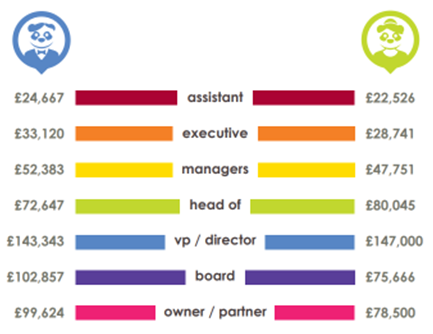If you have been following along with the pandas for a while now, you will be aware that we release an annual eCommerce salary survey, featuring a variety of topics – including the eCommerce gender debate.
We have looked back over the years to see the changes in the gender pay gap, eCommerce gender demographics, and gender equality while discussing why we decided not to include the eCommerce gender debate in the 2021 and 2022 eCommerce Salary Survey.
Let’s get into it…
eCommerce gender pay-gap
The gender pay gap is a problematic topic, and back in 2018, we noticed a difference in salaries for men and women, which led us to mention it in our salary survey. This is what we found:

A clear example of this can be seen above, where men working at the top of the company as an Owner / Partner were earning around £99,642 per year, whilst their female counterparts were earning £78,500 for the same job. That is a considerable difference!
As you can also see, there have been situations where women have earned more than men. Above it states that women in ‘Head of’ roles earned £80,045 on average in 2018, whereas men earned £72,647. Although there seems to be a little bit of a give and take, there is a larger difference between the salaries of male and female Owners / Partners, and less so for Head of positions.
eCommerce gender representation
In 2019, we began to see a slight increase in the number of women, compared to men, in more senior positions. For example, we saw that:
- Female presence in a Senior Manager position increased from 14% to 18%
- Female presence in a Head of position increased from 8% to 15%
We saw that in the same categories, the male presence reduced, but could this be due to more women entering the eCommerce industry?
To find out, we looked at the percentage of men and women in the industry over the years.
- 2018 – 51% of respondents were men, 48% were women, and 1% preferred not to say
- 2019 – 51% of respondents were men, 48% were women, and 1% preferred not to say
- 2020 – 48% of respondents were men, 52% were women
- 2021 – 50% of respondents were men, 49% were women, 1% were transgender
- 2022 – 44% of respondents are men, 55% are women, 1% are transgender
As you can see, in 2022, there are more women than ever working in the eCommerce industry, outweighing men. We did see the ratio of women to men increase in 2020, but this year was the first time we have seen nearly a 10% difference.
We are pleased to see an increase in female representation in the eCommerce sector, and it seems that women are beginning to take over more spots in the industry.
Why do you no longer share information on the gender pay gap?
2020 was the last year that we researched the gender debate, more specifically the gender pay gap, and the main reason behind this was because the response we received regarding the difference in the pay rate, demographic, and equality was so minimal, and was equalling out throughout the years, it wasn’t worth sharing anymore.
Over the years, we have reached out to a large portion of eCommerce professionals, however, this data is only an average, and we aren’t to say that there still isn’t a gender pay gap in the eCommerce industry.
Would you be interested in hearing more about the gender pay gap in next year's report? Let us know in the comments below! You can also download a copy of the full report by clicking below!





-1.png?width=160&height=84&name=ECA23%20Socials%20Email%20FBBest%20eCommerce%20Support%20Business%20(less%20than%2025%20employees)-1.png)
What do you think?
Share your thoughts on this post - whether you agree, disagree or have your own insight to share, we want to hear from you!